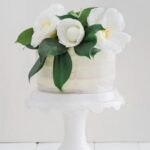Indulging in the art of cake decorating is a delightful experience for bakers and dessert enthusiasts alike. While frosting and icing often take center stage, adding a touch of sweetness and whimsy to cakes can be achieved with the use of candy. From vibrant sprinkles to delicate chocolate truffles, candy offers endless possibilities for creating visually stunning and delicious masterpieces.
In this article, we will delve into the sweet secrets of using candy for decorating cakes. We will explore various techniques, from choosing the perfect candy to incorporating lollipops, chocolate-covered treats, and even candied fruits into your creations. Whether you are a seasoned cake decorator looking to expand your repertoire or a beginner eager to learn the basics, this article aims to provide you with inspiration and guidance.
Candy not only adds color and texture to cakes but also brings out the inner child in all of us. The combination of mouthwatering flavors and eye-catching designs elevates any cake from ordinary to extraordinary.
So join us on this delectable journey as we uncover the artistry behind selecting the right candy, explore its edible gem-like qualities as decorations, discover techniques for painting with candy on cakes, and unleash your creativity through mosaic designs – all while harnessing the vibrancy of tropical candied fruits as garnishes. With these sweet secrets in hand, you will be able to transform simple cakes into extravagant masterpieces that are sure to wow everyone who sees them.
Embark on this delicious adventure where we will unlock the secrets to creating show-stopping cake decorations using candy. Whether you are a professional baker or just someone who loves playful desserts, get ready to take your cake decorating skills to the next level with our step-by-step instructions and helpful tips.
Let’s dive in and discover how candy can truly transform your cakes into works of art that are both enticing to look at and delightful to eat.
The Art of Candy Selection
Choosing the right candy for decorating cakes is an art form in itself. The right candy can enhance the theme, color scheme, and overall look of your cake. Here are some tips on how to choose the perfect candy for your cake:
- Consider the Theme: Start by considering the theme or occasion of your cake. Is it a birthday cake? Wedding cake? Baby shower cake? Understanding the theme will help you choose candies that align with the overall concept. For example, if it’s a beach-themed cake, you might consider using gummy sharks, seashell-shaped chocolates, or even rock candy as “coral.”
- Color Coordination: Pay attention to the colors in your cake design and select candies that match or complement these colors. Creating a visually appealing color palette can tie the whole design together. You can use colorful candies like M&M’s, Skittles, or jelly beans to add pops of color to your cake.
- Texture and Size: Think about the texture and size of the candy you want to use. Do you want something crunchy? Chewy? Smooth? Consider how these textures will work with your cake’s overall texture and taste profile. Additionally, choose candies that are in proportion to your cake’s decoration size – smaller candies may get lost while larger ones may overwhelm.
- Kinds of Candy: There are countless types of candy available for decorating cakes, including sprinkles, nonpareils, chocolate chips, licorice strings, gumdrops, and more. Use a combination of different types to add variety and visual interest to your design.
When choosing candy for decorating cakes, remember that creativity is key. Don’t be afraid to experiment with different flavors and textures or mix unexpected combinations – they might just lead to beautiful and tasty results.
Edible Gems
Candy is not only a delicious treat but also a versatile and colorful decoration option for cakes. One exciting way to use candy as decorations is by transforming them into edible gems. These edible gems can add a touch of elegance and sparkle to any cake design.
When it comes to choosing the perfect candy for creating edible gems, it is important to consider the shape and color of the candy. Hard candies like Jolly Ranchers or lollipops work well for creating gem-like shapes, while colored gummy candies can be molded into different shapes with the help of heat. It is also possible to make your own hard candy using silicone molds in various gemstone shapes.
To give your edible gems that realistic shine, you can use a clear glaze or edible glitter. Simply brush the glaze or sprinkle the glitter onto the surface of the candy after it has cooled down and hardened. This will create a beautiful shimmering effect that mimics real gemstones.
The placement of these edible gems on your cake is crucial in creating an eye-catching design. Consider arranging them in a scattered pattern across the surface of the cake or clustering them together for an elegant focal point. You can also experiment with different sizes and colors to create a visually stunning effect.
Using candy as edible decorations allows for endless creativity and customization in cake designs. Whether you are making a birthday cake or an elaborate wedding cake, incorporating edible gemstones adds a unique touch that will surely impress your guests.
| Shape | Candy Options |
|---|---|
| Gem-like Shape | Jolly Ranchers, Lollipops |
| Moldable Shape | Colored Gummy Candies |
| Custom Shape | Made with Silicone Molds |
Candy Painting
Candy painting is a creative technique that can elevate your cake designs to a whole new level. By using different types of candies and strategic placement, you can create stunning designs that will impress everyone who sees them. In this section, we will explore some techniques for candy painting that will help you create edible works of art.
Choosing the Right Candy
The first step in candy painting is selecting the right candies for your design. You want to choose candies that have vibrant colors and interesting shapes. Hard candies with a clear or translucent appearance work particularly well for this technique because they allow light to pass through, creating an eye-catching effect. Gummy candies can also be used, but keep in mind that they may not create the same level of transparency as hard candies.
Preparation and Placement
Before you begin candy painting, it’s essential to prepare your surface properly. Make sure your cake is fully cooled and free from any crumbs or debris. Apply a thin layer of frosting or ganache as a base for the candies to adhere to.
When it comes to placement, think about how you want your design to look and plan where each candy will go. Consider using different sizes and shapes of candies to add depth and dimension to your design. You can create patterns or images by strategically placing the candies on the cake surface.
Techniques for Candy Paint
There are several techniques you can use when candy painting on cakes. One technique involves crushing hard candies into small pieces and melting them in the oven at a low temperature until they become liquid. Pour this liquid over the cake surface using a spoon or squeeze bottle, then use a paintbrush or toothpick to spread and manipulate the candy into desired patterns or designs.
Another technique involves using gels or food coloring mixed with sugar syrup to create edible paint. This paint can be applied directly onto the cake surface using a brush or sponge, allowing for more precise control over the design.
Experiment with different techniques and have fun exploring the endless possibilities of candy painting on cakes. With practice and creativity, you can create stunning candy designs that will truly amaze your friends and family.
Candy Mosaic
Candy mosaic cake designs offer a unique and creative way to decorate cakes. By arranging various types and colors of candy, you can create stunning and vibrant patterns that will impress both children and adults alike. In this section, we will explore the art of creating candy mosaics and provide some tips to help you unleash your creativity with these colorful designs.
When it comes to candy mosaics, the options are endless. You can use a wide range of candies such as M&M’s, Skittles, jelly beans, gummy bears, licorice, or any other small and colorful candies that you prefer. The key is to select candies that have different shapes, sizes, and colors to add depth and interest to your design.
To create a candy mosaic, start by baking your cake as usual and letting it cool completely. Then take your chosen candies and separate them by color or type. This will make it easier for you to organize your design. Next, apply a thin layer of frosting on top of the cake to act as an adhesive for the candies.
Now comes the fun part – arranging the candies. Start by outlining your design with one color or type of candy. It could be a simple shape like a heart or a more intricate pattern like waves or flowers. Once you have the outline in place, fill in the rest of the design using different colors or types of candies. You can be as precise or as random as you like.
To add extra flair to your candy mosaic cake design, consider adding other edible decorations such as sprinkles or edible glitter around the edges or in between the candies. This will enhance the overall look of your design and make it even more visually appealing.
By experimenting with different colors, shapes, and arrangements of candy, you can create truly unique mosaic designs that are sure to impress. Whether you’re decorating a birthday cake or just want to add some pizzazz to an ordinary cake, candy mosaics provide a fun and artistic way to express your creativity and make your cakes stand out. So go ahead, unleash your imagination, and create your own candy masterpiece.
Lollipops and Suckers
Lollipops and suckers are not just delicious treats on their own, they can also be creatively used to enhance the appearance of cakes. By incorporating these colorful candies into cake decorations, you can add an element of fun and playfulness to your creations. In this section, we will explore some creative ways to use lollipops and suckers as cake decorations.
One simple yet effective way to incorporate lollipops and suckers into cake decorations is by sticking them directly into the cake. You can choose lollipops or suckers in different colors, sizes, and shapes to create a visually appealing arrangement on top of the cake. These candy sticks can serve as edible cake toppers that instantly grab attention and make your creation stand out.
Another creative way to use lollipops and suckers is by crushing them and using the crushed candy as a decorative element. You can sprinkle the crushed candy over the frosting or icing on the cake for a colorful and textured effect. This technique works particularly well when you want to add some crunchiness and extra sweetness to your cakes.
Furthermore, lollipops and suckers can also be used as part of thematic cake decorations. For example, if you are decorating a birthday cake with a circus theme, you can utilize assorted lollipop flavors, colors, and sizes to create a vibrant circus tent look on top of the cake. This not only adds visual interest but also ties in with the overall theme of the celebration.
To summarize, lollipops and suckers offer endless possibilities for creative cake decorations. Whether it’s by using them as edible toppers, incorporating crushed candy for added texture or as part of thematic designs, these colorful treats are sure to delight both children and adults alike. So next time you’re decorating a cake, don’t forget about the artistic potential that lollipops and suckers bring.
| Ways to Incorporate Lollipops and Suckers into Cake Decorations |
|---|
| Sticking lollipops and suckers directly into the cake as edible cake toppers |
| Using crushed lollipops and suckers as a decorative element by sprinkling them over the frosting or icing |
| Incorporating lollipops and suckers in thematic cake decorations to enhance the overall design |
The Power of Chocolate
Choosing the Right Chocolate-covered Candy
When it comes to using chocolate-covered candy to enhance your cake designs, choosing the right type of candy is essential. The key is to select candies that complement the flavor profile of your cake while adding visual appeal. For example, if you are working with a rich chocolate cake, consider incorporating chocolate-covered espresso beans or chocolate-covered almonds for an added crunch and burst of flavor.
On the other hand, if you are working with a lighter cake base, such as a vanilla or lemon, opt for chocolate-covered strawberries or raspberries to provide a contrast in taste and texture. It’s important to consider not only the taste but also the size and shape of the candy to ensure it fits seamlessly into your design.
Incorporating Chocolate-covered Candy as Cake Decorations
Chocolate-covered candy can be used in various ways to elevate your cake designs. One popular technique is placing individual pieces of chocolate-covered candies around the edges of the cake layers or on top as a border. This creates visual interest and adds depth to your design. Another creative way to incorporate chocolate-covered candy is by using them as accents on top of cupcakes or as decorative elements around a larger centerpiece cake.
For those looking to take their cake decorating skills up a notch, try creating intricate designs using melted chocolate-covered candy. Melted chocolate can be used to create elegant drizzles over cakes, as well as delicate patterns such as lace or floral motifs. Simply melt the chocolate in a microwave-safe bowl or over a double boiler, transfer it into a piping bag with a small tip, and let your creativity flow.
Mixing Different Flavors and Textures
One advantage of using chocolate-covered candy in cake decorating is the ability to mix different flavors and textures. By combining different types of candies with varying coatings such as dark, milk, or white chocolate, you can create a visually stunning and unique experience for your taste buds. Experiment with contrasting flavors, such as pairing a tart and fruity candy with a rich and creamy chocolate coating.
Furthermore, consider combining different textures, such as crunchy caramel-covered candies with smooth chocolate coatings, to add dimension and complexity to your cake designs. This interplay of flavors and textures will not only make your cakes more visually appealing but also provide an exciting sensory experience for those enjoying your creations.
Using chocolate-covered candy to enhance your cake designs opens up a world of possibilities. Whether you are opting for subtle decorations or bold statements, the power of chocolate-coated candies can take your cakes from ordinary to extraordinary. So go ahead, unleash your creativity and indulge in the sweet wonders that chocolate-covered candy can bring to your cake decorating endeavors.
Tropical Delights
In the world of cake decorating, creativity knows no bounds. One way to add a burst of color and flavor to your cake designs is by incorporating candied fruits as decorations. These vibrant and delectable treats can transform any ordinary cake into a tropical delight. The use of candied fruits not only adds visual appeal but also enhances the taste profile of your creations.
When it comes to choosing the perfect candied fruits for your cake decorations, there are a few things to consider. Firstly, opt for fruits that are firm and have a good balance between sweetness and tartness. Some popular choices include cherries, citrus slices (such as lemons or oranges), pineapple rings, and even ginger slices. You can find these candied fruits in specialty stores or make them at home by simmering them in simple syrup until they become tender and translucent.
Once you’ve selected your desired candied fruits, it’s time to get creative with your cake designs. Consider using them as garnishes on top of your cakes or arrange them in decorative patterns around the sides. They can also be used as accents on cupcakes or as toppings for layered desserts like trifles or parfaits. The vibrant colors and unique textures of the candied fruits will add dimension and visual interest to your creations, making them truly stand out.
Not only do candied fruits add beauty to your cake designs, but they also bring an extra layer of flavor to each bite. The sweetness from the candy-coated fruit complements the rich flavors of the cake itself, creating a harmonious blend that will leave your guests wanting more.
Whether you’re looking to create a beach-themed cake or simply want to add a touch of tropical flair, harnessing the vibrancy of candied fruits is an excellent way to elevate your cake decorations and take them to new heights.
Candy Garnishes
When it comes to cake decorations, candy garnishes can truly elevate your creations from ordinary to extraordinary. Just imagine a simple vanilla cake adorned with a colorful array of candies, turning it into a stunning centerpiece that will impress your guests. In this section, we will explore the art of using candy as toppings and garnishes to transform your cakes into works of art.
One popular technique for creating candy garnishes is to use crushed or chopped candies to create a textured topping. This can be done by simply crushing hard candies like peppermints or lollipops into small pieces and sprinkling them over the frosting. The result is an eye-catching mosaic of colors and textures that adds both visual appeal and a delightful crunch to every bite.
Another creative way to incorporate candy into your cake decorations is by using molded or shaped candies as edible accents. Candy molds come in various shapes and sizes, allowing you to create everything from delicate flowers to whimsical animals.
These molded candies can be strategically placed on top of the cake or used as decorative borders around the edges. Not only do these edible gems add visual interest, but they also provide a burst of flavor when enjoyed alongside each slice of cake.
If you want to take your candy garnishes to the next level, consider incorporating chocolate-covered candy into your designs. The smooth and velvety texture of chocolate-covered nuts, fruits, or even marshmallows provides an elegant touch that complements any cake flavor. Whether you choose to drizzle melted chocolate over the top or arrange whole pieces as decorative accents, these sweet additions are sure to wow your guests.
Conclusion
In conclusion, candy can truly take your cake decorating skills to the next level and transform simple cakes into extravagant masterpieces. From choosing the perfect candy for your cake to exploring the various ways in which candy can be used as edible decorations, there are endless opportunities for creativity and innovation in cake decorating with candy.
One of the key aspects to consider when working with candy is the art of selection. By carefully choosing candies that complement the flavors and aesthetic of your cake, you can create a harmonious and visually appealing masterpiece. Whether it’s using colorful lollipops and suckers or chocolate-covered candies, each piece of candy adds its own unique touch to your design.
Furthermore, candy presents the opportunity for intricate designs and artistic expression. Techniques such as candy painting allow you to create stunning designs directly on the surface of your cakes, while candy mosaics unleash your creativity by allowing you to arrange small pieces of candy into beautiful patterns. These techniques give you complete control over your design and enable you to create truly one-of-a-kind cakes.
Finally, don’t forget about the power of garnishes. By utilizing candied fruits or other types of candy as toppings on your cakes, you can add an extra layer of flavor and visual appeal. The vibrant colors and textures of these garnishes can make even a simple cake look like a work of art.

Welcome to my blog about home and family. This blog is a place where I will share my thoughts, ideas, and experiences related to these important topics. I am a stay-at-home mom with two young children. I hope you enjoy reading it! and may find some helpful tips and ideas that will make your home and family life even better!





